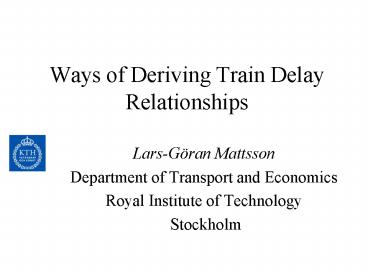Ways of Deriving Train Delay Relationships PowerPoint PPT Presentation
1 / 18
Title: Ways of Deriving Train Delay Relationships
1
Ways of Deriving Train Delay Relationships
- Lars-Göran Mattsson
- Department of Transport and Economics
- Royal Institute of Technology
- Stockholm
2
Introduction
- Reliability of train services is an important
performance indicator - Relevant for investment planning, timetabling and
operational planning - We need validated relationships between the
design and utilisation of the system and the
amount of delays - A review of ways of deriving such relationships
- Analytical approaches
- Micro-simulation approaches
- Statistical approaches
3
What is special with railway service?
- Safety in focus
- Disturbances and fault are not allowed to reduce
safety rather delays - Impossible to pass an obstacle on the track
- Many subsystems in series (track, signal, power
systems, rolling stock, crews etc.) - Controlled and regulated system
- These properties make the railway system
sensitive to disturbances
4
Terminology
- Delay actual running time minimum running time
- Scheduled delay scheduled running time
minimum running time - Unscheduled delay actual running time
scheduled running time - Unscheduled delay primary delay secondary
delay - Primary delay delay caused by some external
exogenous circumstance - Secondary delay delays that are caused by other
trains and hence are increasing with capacity
utilisation
5
Capacity
- Capacity ? maximum number of trains that can
operate on a railway section during a given time
period (maximum train flow fmax) - Capacity is determined by the maximum of the
product of speed v and density d according to the
general law of traffic fmax max(v ? d) - dmax depends e.g. on the number of tracks (single
track ? meetings double track ? overtakings)
and on the timetable (speed heterogeneity) - Capacity consumption the time the rail section
is occupied as a percentage of the considered
time window
6
Large economies of scale in capacity provision
? Two stations 50 km apart ? 5 min buffer time
for meeting ? 5 min minimum headway ? 5 min for
overtaking
7
Analytical delay analysis
- Huisman och Boucherie (2001)
- Trains in one direction without overtaking
possibilities - Single section no network analysis
- Delays caused by slower trains obstructing
- faster trains
- Relies on queuing theory
- Both for strategic and operational planning
- Moderate data demanding
8
Regional (R), inter-regional (IR) and inter-city
(IC) trains with minimum running time of 48, 36,
33 min for a 67 km section. Random order,
exponential headway, however minimum 2 min. The
same intensity for all train types Source
Huisman and Boucherie (2001)
9
Micro-simulation approaches
- Detailed delay analysis requires micro-simulation
- RailSys is a system for timetable design that has
been applied in Sweden - Can also be used for delay analysis
- Requires detailed data about tracks, signals,
block sections, gradients, train types
(acceleration, deceleration), timetable - Possible to simulate random arrival pattern of
the trains, stochastic dwelling times at the
stations - Resource demanding analysis
10
Simulation of a major technical breakdown
- Fire in the interlocking system at a station
- All signals at the station were put out and the
switches could not be used - Reopened as a double-track instead of four tracks
and with a manual signal system - Maximum speed reduced to 40 km/h
- Only half of the traffic was allowed (66 trains
per day) - After extensive calibration ? simulated mean
delay 16.1 min versus 17.6 min in reality
11
Mean delay (hhmm) by time of the day
More trains 84, the same 66, fewer 50 per
day
Source Wiklund (2003)
12
Mean delay per day (hhmm) /- one standard
deviation
Train/h
Source Wiklund (2003)
13
Consumers perspective on reliability
- So far producers perspective
- Delayed trains
- Consumers perspective more interesting
- What is the travel time uncertainty for a journey
from A to B? - Not only delayed trains/buses
- Missed connections important
- Rietveld et al. (2001) have developed a
methodology - Random sample of journeys
- Running time statistics for sections of the
journeys - Independence assumption
- Possible to simulate the travel time uncertainty
for the whole journey
14
Mean simulated travel time as a percentage of
scheduled travel timeA sample of Dutch journeys
Source Rietveld et al. (2001)
15
Statistical approaches
- Real data
- Regression analysis of the relationship between
capacity consumption and secondary delay - Gibson et al. (2002) report on one such study
from Britain - Dit Aiexp(?Cit) with 1 lt ? lt 4
- Could also be interesting to relate delays to
extreme weather conditions - Simulated data
- Could be an interesting possibility
16
Conclusions 1
- Surprisingly little published on cause-effect
relationships for train delays - Most studies has a supply or producer perspective
- A demand or consumer perspective would be more
interesting - More or less impossible to model the causes of
primary delays - Should be possible to find relationships between
the amount of primary delays and technical
standard, maintenance activities, weather
conditions etc.
17
Conclusions 2
- How primary delays and capacity consumption
affect secondary delays could be studied by - analytical approaches
- micro-simulations approaches
- statistical approaches
- Analytical approaches
- Requires not so much data
- Limited computational burden
- Leads to less detailed results
- Particularly useful for strategic decisions
18
Conclusions 3
- Micro-simulations approaches
- Requires detailed data (infrastructure, trains,
timetable) - Enables detailed analyses
- Particularly useful for construction of robust
timetables - Statistical analysis of simulated delays
- Could be carried out as a statistical experiment
- Requires an extensive series of simulations
- Is probably the most reliable way of deriving
cause-effect relationships for train service
reliability

